| Columns Retired Columns & Blogs |
Beautiful speaker, and I'm sure it sounds great. But for that price you can just about get into a nice used set of Olympica III and have a great floor standing speaker with significantly deeper bass.
I used DRA Labs' MLSSA system to measure the Sonus Faber Olympica Nova 1's farfield behavior with a calibrated DPA 4006 microphone. For the speaker's nearfield response, I used an Earthworks QTC-40 mike, as its ¼" capsule won't obstruct the radiated sound. The Olympica Nova 1's specified sensitivity is 87dB/2.83V/m. My estimated sensitivity was very close to that figure, at 86.7dB(B)/2.83V/m. Although the Olympica Nova 1's nominal impedance is specified as 4 ohms, the solid trace in fig.1 reveals that the impedance remains above 4 ohms for the entire audioband. The minimum value is 4.2 ohms at 205Hz, and while the electrical phase angle (dashed trace) is high at some frequencies, this will be ameliorated by the high impedance magnitude at those frequencies. The Olympica Nova 1 will be easy to drive.
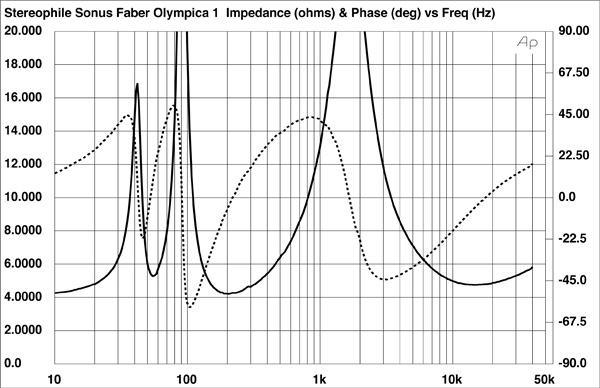
Although the enclosure doesn't have any parallel walls, which should minimize internal standing waves, it didn't appear to be as well-damped as I was expecting from the multi-layer construction. When I listened to the panels of both loudspeakers with a stethoscope while I swept a sinewave tone up and down, I found a strong resonant mode just below 300Hz on the sidewalls and the top panel. (Although it will be difficult to see at the scale that graphs are printed, there is a small wrinkle in the impedance traces in this region.) When I investigated the enclosure's vibrational behavior with a plastic-tape accelerometer, this mode was very strong on the sidewalls (fig.2), and modes were also present at 550Hz and 630Hz. This behavior might correlate with the slight midrange coloration Larry heard on Richard Lehnert's speaking voice on the Stereophile Editor's Choice CD.
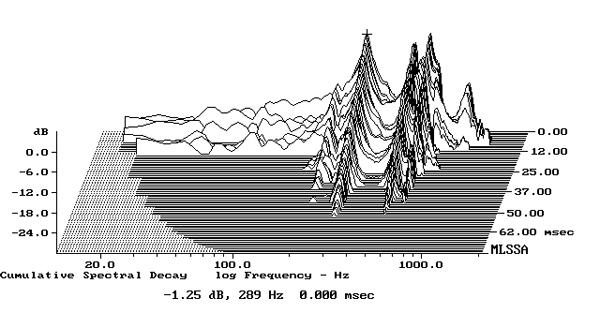
The Sonus Faber's slot-shaped port is tuned to 55Hz, this indicated by the fact that the nearfield response of the woofer (fig.3, blue trace) has its minimum-motion notch at that frequency. (The back pressure from the port resonance holds the cone stationary at this frequency.) The nearfield response of the port (red trace) peaks between 38Hz and 90Hz, but its upper-frequency rolloff is disturbed by peaks at the frequencies of the enclosure's resonant modes. The woofer's output is relatively even and it crosses over to the tweeter (green trace) close to the specified 2.5kHz. The tweeter appears to be 5dB too high in level, however, which can also be seen in the Olympica Nova 1's farfield response, averaged across a 30° horizontal window centered on the tweeter axis (fig.4, black trace above 300Hz). The other speaker's tweeter was about 1dB lower in level, but the responses of the two samples otherwise closely matched. A slight lack of energy in the crossover region can be seen in this graph.
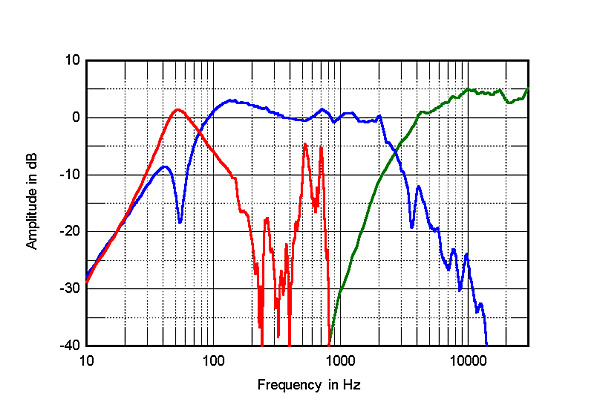
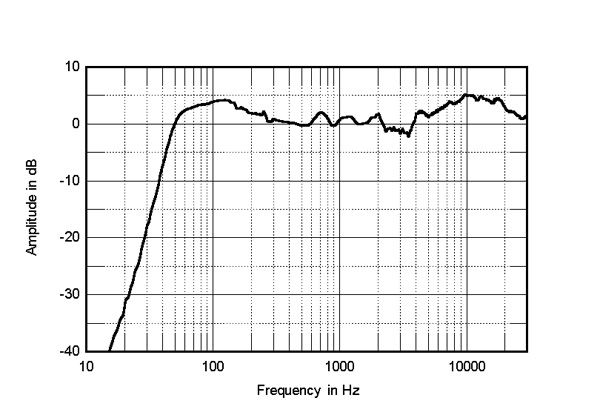
The black trace below 300Hz in fig.4 shows the sum of the Sonus Faber's nearfield woofer and port outputs, taking into account acoustic phase and the different distance of each radiator from a nominal farfield microphone position. The small excess of upper-bass energy will be due to the nearfield measurement technique, which assumes that the radiators are mounted on a true infinite baffle, ie, one that extends indefinitely in both horizontal and vertical planes.
The plot of the Olympica Nova 1's horizontal dispersion, referenced to the response on the tweeter axis (fig.5), indicates that the speaker's output drops off to the sides above 10kHz. This will tend to balance some of the on-axis high-treble excess in medium-sized and large rooms, though the sound might still be rather bright in small rooms. Other than some small disturbances in the midrange at off-axis angles greater than 60°, the contour lines in this graph are relatively even throughout the midrange and treble. This will correlate with stable stereo imaging. In the vertical plane (fig.6), a suckout develops in the crossover region 5° above the tweeter axis. Sonus Faber's dedicated stand, which is just under 30" tall with spikes, will place the tweeter sufficiently high for this suckout not to affect the Sonus Faber's tonal balance (footnote 1).

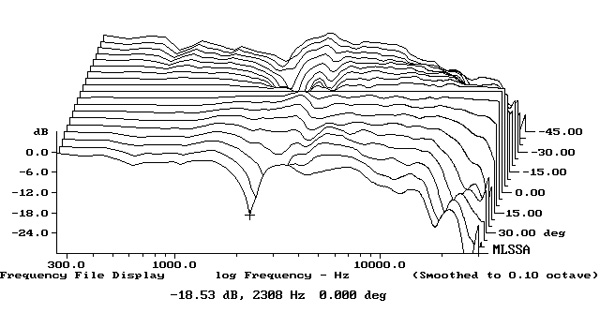
The red trace in fig.7 shows the Sonus Fabers' spatially averaged response in my room. (This is generated by averaging 20 1/6-octave–smoothed spectra, taken for the left and right speakers individually using a 96kHz sample rate, in a vertical rectangular grid 36" wide by 18" high and centered on the positions of my ears.) For reference, the blue trace shows the spatially averaged response of my KEF LS50s when placed in the same positions. The in-room response of the two models is very similar in the upper bass and midrange, and while the Olympica Nova 1s have more mid-bass energy and low-frequency extension, the KEFs have more output in the presence region. More importantly, while the sloped-down response above 5kHz of the LS50s is due both to the increased absorptivity of the room's furnishings in this region and the increasing directivity of the tweeter, the Sonus Faber speakers have up to 4dB greater output between 5kHz and 20kHz. This correlates with the high tweeter level that can be seen in the quasi-anechoic behavior (figs.3 and 4).
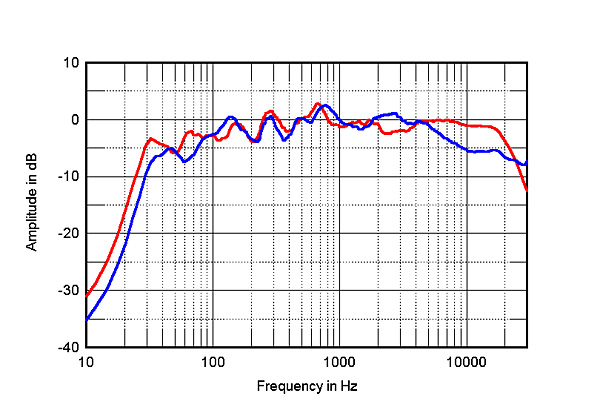
In the time domain, the Olympica Nova 1's step response on the tweeter axis (fig.7) indicates that the tweeter and woofer are both connected in positive acoustic polarity. The decay of the tweeter's step, which arrives first at the microphone, smoothly blends with the start of the woofer's step. The Sonus Faber's cumulative spectral-decay plot (fig.8) is very clean throughout the treble. However, a ridge of decayed energy is evident at 2kHz, which could possibly be due to a surround termination problem with the woofer. (As always with my CSD plots, ignore the small ridge just below 17kHz, which is due to interference from the computer monitor's line-scan frequency.)
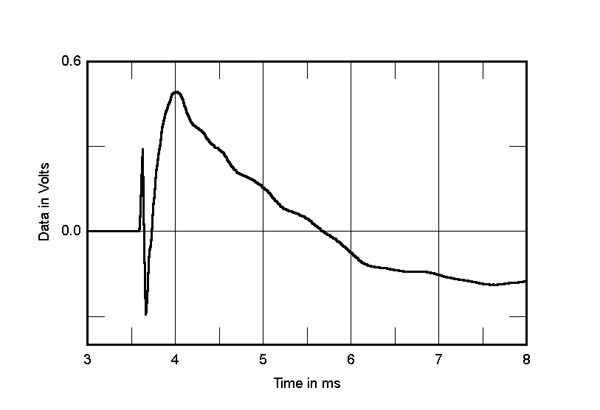
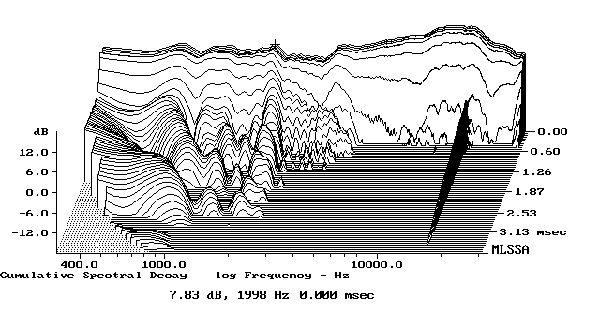
Other than the resonant mode at 2kHz in fig.8 and the midrange peaks in the port's output, the Sonus Faber Olympica Nova 1 did well on the test bench.—John Atkinson

Beautiful speaker, and I'm sure it sounds great. But for that price you can just about get into a nice used set of Olympica III and have a great floor standing speaker with significantly deeper bass.

I heard the Nova 5 at some length at RMAF in September, so I don't agree that my opinion is any more pretentious than yours or anyone else's.

As I do own both and you admitted to never hearing the Nova 1 it is pretentious as most of you so call AP types are.
Sour grapes eh.

Umm, okay if you say so, that the Nova 1 sounds quite different from the Nova 5.

Yes for my larger/family room I have the 5 and for my office I have Nova 1 and prefer listening in my office with my Simaudo 390/330A, Rega P8.
So with you never hearing the I and making assumptions on a demo is not only pretentious it is comical at best.
Cheers.

So, are you saying the Nova 1 has a significantly different sound from the Nova 5, or not? You don't seem to want to answer that question. If that is the case, then people need to know that.

Depending on reviews from sod's like your self that have never listened to either would be better served by a professional review as found on these page's.
Make it sound like you are working on a cure for cancer.
Yes jam those Nova 5 in a small office and they sound like shite!
But one must make the determination them self bu demoing on similar gear in a similar sized room as their listening room.
Opinions are like what?????????????
I prefer the Nova 1 in my office for listening to music (all genre's)
So long Trot!

the guy practically bragging that he's got a ton of disposable income calling someone else pretentious.... are you the pot or the kettle?
Oh, and if the I sounds significantly different than the III (instead of similar but with better dynamics/bass), then Sonus Faber is not doing it right - and I'm pretty sure they're doing it right.

Pot calling the kettle Bernie.
You opening salvo said it all.
I am blessed with being able to work hard be rewarded and surround my self and my family with the trappings they enjoy.
So go ahead call be pretentious and you are consumed with envy.
Try working harder and getting the things you want in life not just what you need.
Please do take a reading comprehension course the point was an opinion had been formulated without ever hearing either speaker.
Bet after you take that course you will do better in life.
Cheer's

is something that you will never have... just like that orange, vienna sausage finger having simpleton in the White House who thinks gold plating everything makes it more classy lol. Oh, and since you weirdly went there; I actually come from a family with more money/connections than you'll ever have (and I work my butt off too, bub, and will be starting a new business soon - excited about that).
You make the mistake so many simple people make equating money with morality - most (but not all!) millionaires I know, and I know quite a few of them including my family and myself (old money ftw), are kinda douchey. People secure in themselves don't need to advertise what they have, only the insecure do that. I'm both happy and secure in my self, but you? Not so much, quite obviously.
Bernie is not my first (or second) choice for president, but go on making unfounded assumptions. I wouldn't be bothered by his election (any Democrat(ic socialist) will do), and I consider the Senate a bigger "get" for the Dems anyway because I actually understand how the US gov't is set up constitutionally.
Also, before you critique someone's writing/reading... make sure you can properly use the English language first.
* to the editor, sorry if I'm cranky - I've had the (actual) flu all week and have lost the patience required for suffering fools like this one.

Oh poor child has the flu.
So sorry.......
Also your post is total gibberish and you do need those classes.
BTW Could care less about your political out look was referring to Weekend At Bernie's
Triggered!
So enjoy your feeble flu in your feeble life.
Later Cheeto Breath....

I did enjoy your rant though.
Good luck with your new business.

Yes. I don't understand why this dude is calling ME pretentious because I would expect the Nova 1 to sound very similar to the Nova 5, which I heard at some length at RMAF. And I don't understand why he keeps saying that I've "never heard either", as I've stated repeatedly here that I heard the Nova 5. Weird.

As I do own both and you admitted to never hearing the Nova 1 it is pretentious as most of you so call AP types are.
Sour grapes eh.

.... and less so in the deep bass—unsurprisingly for a smallish loudspeaker." quoted Larry Greenhill.
I seldom go for whoever critics audio reviews as I only rely on my ears.
But this time, I full agree to what Greenhill's review on the bookselvers' lack of bass. This is physics.
NO, repeat, no so claimed "full range" loudspeakers, big or small, can reproduced deep bass music as already recorded realistically e.g. church/concert hall pipe organ floor shaking deep bass, or synthetic bass in pop music.
Only viable solution for consumers is to add active subwoofers to retrieve the deep bass music of the original recordings. NO other choice.
That is why I've added 3 active subwoofers to my stereo rig: L, R & L+R to retrieve the missed deep bass music years back.
I never look back as I am so gratified what I have done.
Listening to deep bass is believing
Jack L
Canada

Hi
Are you tellng us Greenhill's above commnent on small loudspeakers not reproducing adequate was a BS?
He is 100% correct. IMO, NO so claimed "full range" loudspeakers, big or small, can reproduce deep bass realistically, e.g. floor shaking deep bass of church/concert hall pipe organ music, & synthesized bass notes of rock music.
To achieve this deep bass effect, active subwoofers are indispensable. This is my years hands-on experience.
Listening to deep deep bass is believing
Jack L
Canada

I always find the level of illiteracy among those who claim to be professionally successful, as in this individual's case, to be quite disturbing. Can one truly be considered a 'success' in life when unable to string a simple sentence together and possessed of the vocabulary of a 9-yr old? It's perfectly reasonable to suggest, as the first poster did, that a larger loudspeaker will, all else being equal, have greater bass extension than a smaller one. This is a matter of fact, not of opinion. Why then was he suggested to be 'pretentious' because he hadn't heard both loudspeakers? Do you even understand what this word means? Look up the meaning of this adjective and then compare it to your statements for an example of its true meaning. I've met a number of compulsive liars in the past, and your mouthy behaviour mirrors theirs to a tee. This is not the place for you...

You expressed exactly my sentiments, good sir. I am left here scratching my head why this juvenile and bizarre conversation took place in the first place.

Apologies if I'm wrong, but was the initial disagreement based on this comment by mtrot
But for that price you can just about get into a nice used set of Olympica III and have a great floor standing speaker with significantly deeper bass
What exactly is wrong with this statement, and how is it an assumption? The Olympica III is a floor standing speaker, with a significantly larger volume cabinet, of course the bass is going to reach deeper.

A suck out around crossover may be related to incorrect sound around crossover: to slightly deemphasize more incorrectly produced frequencies.
I have seen measurement of some speakers with different crossover point (not the frequency where ears are most sensitive). There was a suck out, too.